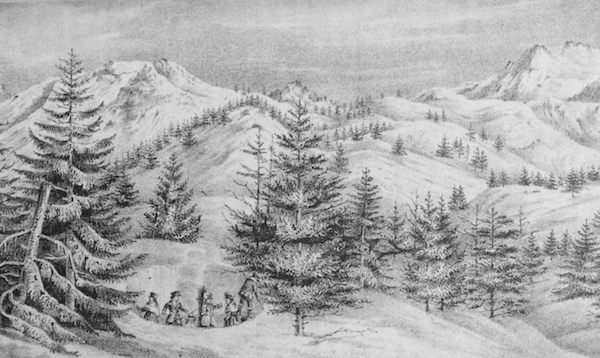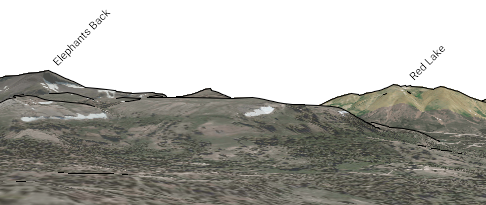On this day in 1844, John C. Fremont and Charles Preuss summited Red Lake Peak. It wasn’t a particularly impressive climb, or circumstance; it was however the first documentation of an identifiable peak climbed in the Sierra. Surely many people climbed peaks before this, but since this blog is a place where we document climbs of peaks (and other hikes), the 171st anniversary of the first documented peak climb seems significant. In any case, repeating this climb seemed like the best possible way to spend a Valentine’s Day.
Historical Fun Fact: Red Lake Peak was not named when Fremont and Preuss climbed it in 1844. It wouldn’t get its name until two decades later. A bit of detective work is required to figure out which peak Fremont was actually describing as having climbed on February 14th. But I think the issue has been put to rest by some in depth analysis of geology along with a great sketch of the area they camped in.


Red Tape: A permit is required to park at the trailhead (Meiss Meadow SNO-PARK) between November 1 and May 30. This permit can be obtained online through the California State SNO-PARKS website. At the time of this post, the day permit cost $6.95, including a $1.95 service fee. They can be printed as soon as you purchase them, so yes – you can wait until the very last minute to secure your permit. During the summer, there is also a parking fee. According to SummitPost it is $3, but this may be out of date so bring some extra cash, just in case.
Directions to Trailhead: Red Lake Peak can be accessed from several different points. We opted to park at Meiss Meadow SNO-PARK near Carson Pass. This parking area is located on the northern side of Highway 88, 5.4 miles past the turnoff for Kirkwood Mountain Resort (when coming from the west) and 9 miles past the 89/88 junction (when approaching from South Lake Tahoe). There are pit toilets located at the trailhead. The parking lot definitely fills up on winter weekends, so get there early or have a backup plan.
[map style=”width:100%; height:400px” kml=”http://www.norcalhiker.com/maps/Red_Lake_Peak.kml” download=”no” elevation=”yes”]Note: GPS based distance is approximate. Download gpx of this route. Download kml of this route.
Trail Description: The climb starts along the Pacific Crest Trail from the Meiss Meadow parking lot. It’s well graded and well traveled – even in the snow. However, you don’t want to follow the PCT for too long. You’ll want to split off to the north, uphill toward Red Lake Peak. The timing of this split-off is really up to you – it depends on the conditions (other tracks in the snow, your preferred route, etc.) During our trip, we followed a very obvious track that took us around the ridge (on the southwest side) and ascended the summit from the west. The terrain is wide open – you can see pretty far in all directions. As long as you have a general idea of where the summit is, you’ll be able to find your way to the top.


The trail has amazing views at every turn. After only about a mile, we seemed to leave all the trees behind as we climbed up into a small drainage. We could see Red Lake Peak to our right (northeast), above and behind a smaller peak/ridge. We didn’t see any snow tracks heading directly up that ridge, so we went contoured around the west side. Our route started to get steep and we really slowed down due to altitude. As we climbed higher we could soon see our destination as well as Lake Tahoe and the prominent peaks of Desolation Wilderness. Upon glimpsing Lake Tahoe, John C. Fremont apparently estimated that it was 15 miles long. Not sure how he did that; I would just say it looks “really big.”


We continued a bit of a traverse around the backside of the ridge, then headed straight up Red Lake Peak via the west face. Every step became more difficult as we gained elevation. We drove up from sea level the same morning – so we really felt it! As we neared the top of the steep slope I said “This is a real mountain.” Christa on the other hand was grumbling: “Nothing like 10,000-ft elevation to make you feel really out of shape!”


The summit of the mountain is a massif of volcanic rock that actually has two peaks. Either summit is climbable, but many consider it to be Class III/IV. I would say it doesn’t really approach Class IV unless you’re going up the wrong way. Not to say there’s a right way, but there seem to be plenty of wrong ways. I couldn’t find any definitive information about which rock outcropping is the highest. If you’re a peak bagger and you care about that sort of thing, just climb both to ensure you’ve reached the high point.



For our hike down, we decided to follow the ridge that we had contoured around on the way up. Some parts of this ridge might be dangerous in extremely snowy conditions, but with the miserable drought we are currently in, we had no difficulty with this route. We actually slid around in quite a bit of mud – basically spring conditions. The views on the way down were just as incredible as on the way up. This hike was exhausting, especially with our lack of acclimatization, but it certainly did not disappoint!




Looks beautiful!